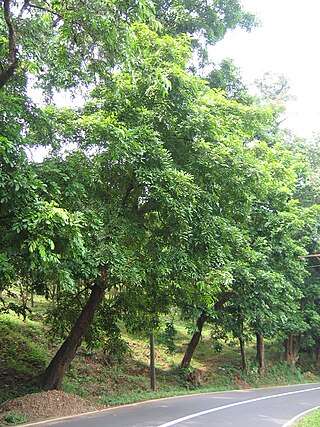
The International Union for Conservation of Nature (IUCN) Red List of Threatened Species, also known as the IUCN Red List or Red Data Book, founded in 1964, is the world's most comprehensive inventory of the global conservation status of biological species. It uses a set of precise criteria to evaluate the extinction risk of thousands of species and subspecies. These criteria are relevant to all species and all regions of the world. With its strong scientific base, the IUCN Red List is recognized as the most authoritative guide to the status of biological diversity. A series of Regional Red Lists are produced by countries or organizations, which assess the risk of extinction to species within a political management unit.

A genet is a member of the genus Genetta, which consists of 17 species of small African carnivorans. The common genet is the only genet present in Europe and occurs in the Iberian Peninsula, Italy and France.

Afzelia xylocarpa is a tree from Southeast Asia. It grows in Thailand, Vietnam, Cambodia, Laos and Burma in deciduous forests. It can reach 30 metres tall with a trunk up to 2 metres in diameter in a mature specimen.

Elattostachys is a genus of about 21 species of trees known to science, constituting part of the plant family Sapindaceae.
This article is a list of biological species, subspecies, and evolutionary significant units that are known to have become extinct during the Holocene, the current geologic epoch, ordered by their known or approximate date of disappearance from oldest to most recent.
Bussea eggelingii is a species of legume in the family Fabaceae. It is found only in Tanzania. It is threatened by habitat loss.
Bussea is a genus of flowering plants in the legume family, Fabaceae.
Myristica xylocarpa is a species of plant in the family Myristicaceae. It is endemic to the Solomon Islands.

Sinojackia xylocarpa is a species of flowering plant in the family Styracaceae. It is endemic to eastern China in Jiangsu province, where it occurs at altitudes of 500–800 m. It is threatened by habitat loss.

Xylia xylocarpa is a species of tree in the mimosoid clade of the subfamily Caesalpinioideae of the family Fabaceae.

The World's 25 Most Endangered Primates is a list of highly endangered primate species selected and published by the International Union for Conservation of Nature (IUCN) Species Survival Commission (SSC) Primate Specialist Group (PSG), the International Primatological Society (IPS), Global Wildlife Conservation (GWC), and Bristol Zoological Society (BZS). The IUCN/SSC PSG worked with Conservation International (CI) to start the list in 2000, but in 2002, during the 19th Congress of the International Primatological Society, primatologists reviewed and debated the list, resulting in the 2002–2004 revision and the endorsement of the IPS. The publication was a joint project between the three conservation organizations until the 2012–2014 list when BZS was added as a publisher. The 2018–2020 list was the first time Conservation International was not among the publishers, replaced instead by GWC. The list has been revised every two years following the biannual Congress of the IPS. Starting with the 2004–2006 report, the title changed to "Primates in Peril: The World's 25 Most Endangered Primates". That same year, the list began to provide information about each species, including their conservation status and the threats they face in the wild. The species text is written in collaboration with experts from the field, with 60 people contributing to the 2006–2008 report and 85 people contributing to the 2008–2010 report. The 2004–2006 and 2006–2008 reports were published in the IUCN/SSC PSG journal Primate Conservation,, since then they have been published as independent publications.







